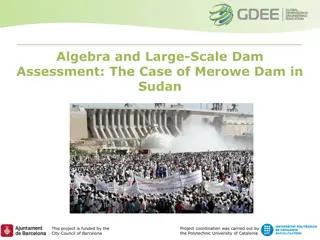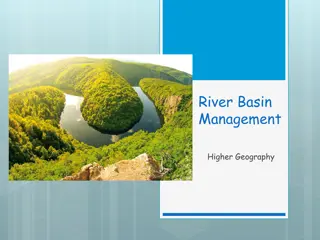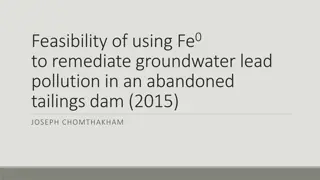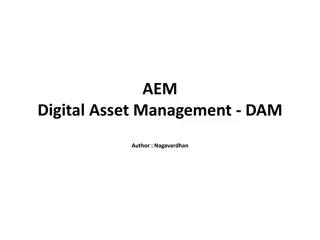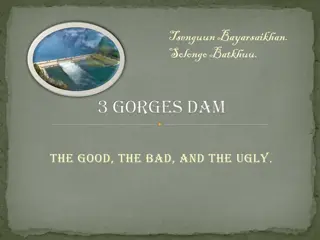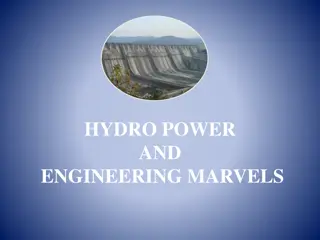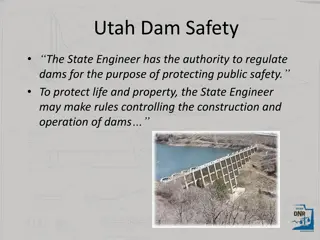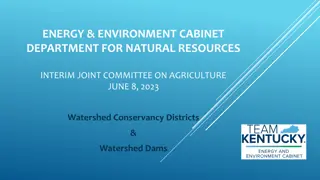Factors Influencing Dam Site Selection and Societal Impacts
Factors affecting dam site selection such as geological stability, drainage density, and rock permeability can reduce construction costs and water loss. The example of the Three Gorges Dam in China illustrates the socio-economic consequences of large dam projects, including displacement of people and inadequate compensation. Physical characteristics of a studied river basin, like temperature variations and rock types, influence its formation and ecosystem dynamics.
- Dam site selection
- Geological stability
- Socio-economic impacts
- River basin formation
- Water management
Download Presentation

Please find below an Image/Link to download the presentation.
The content on the website is provided AS IS for your information and personal use only. It may not be sold, licensed, or shared on other websites without obtaining consent from the author. Download presentation by click this link. If you encounter any issues during the download, it is possible that the publisher has removed the file from their server.
E N D
Presentation Transcript
Narrow and deep valleys can be dammed more efficiently and require less construction materials reducing the overall cost of the project, these valleys also have a reduced surface area and combined with low temperatures they reduce water loss from evaporation (2 marks) If the site has impermeable rock this would reduce water loss from the reservoir by percolation. (1 mark) A geologically stable area away from earthquake zones/fault lines with a solid foundation will reduce the risk of damage or failure of the dam. (1 mark) A high drainage density (or high rainfall) will ensure that the reservoir will receive enough water to avoid transfer from adjacent drainage basins. (1 mark) Or any other valid point. For the Three Gorges Dam, China: Socio-Economic consequences could include: The displacement of millions of people from the Yangtze river region; hundreds of towns and villages were evacuated and later submerged with the area. (1 mark) Those forced to relocate were promised compensation for the value of their homes and land although this did not cover the cost of relocation and some of the money was lost through corruption. (1 mark) Compensation in some instances has been as little as the equivalent of 5 a month, and many claim they have received only half the land compensation they were promised. (1 mark) This has resulted in problems for many as the cities and towns they have had to move to are more expensive, driving many people deeper into poverty. (1 mark) The displaced people are mainly farmers with little formal education this makes it difficult for them to find jobs in the cities and towns they have been relocated to. (1 mark) Flooding the reservoir has forced those farmers still in the region to migrate northwards on to the mountain slopes, adding to erosion.
For a river basin you have studied, outline the physical characteristics that has contributed to its formation. (4)
There is a north/south divide in terms of temperature and rainfall. Upper basin cold and wet, lower basin hot and dry. Much of the lower basin experiences very high temperatures of 40 C or more. Mainly sedimentary rock, such as sandstone. High temperatures lead to expansion and contraction of the rock, which opens up rock fissures. The soil is a thin, red desert soil. The soil is unable to support much vegetation due to semi arid desert area. Only desert plants can survive here. Flow is seasonal - the river is fed by spring melt water. Winter snow melt can cause flooding Rainfall in the system is unpredictable. River levels fluctuate The Colorado is joined by over 25 large tributaries, of which the Green River is the largest by length and discharge. Much of the river basin is very arid. The upper basin is characterised by high elevations, narrow valleys, and a short growing season. The lower basin has lower elevations, wide basins and a long growing season.
Narrow cross section of the valley is required in order to reduce construction costs of the dam (1 mark). A deep valley is required behind the dam as this will result in a smaller surface area for the reservoir, thereby reduce loss from evaporation (1 mark). A site which has impermeable rock would be advantageous as this would reduce loss from the reservoir by percolation (1 mark). A site which is close to construction materials would help to reduce the cost of transporting these materials to the construction site (1 mark). An area free from earthquakes or subsidence is needed as the area needs to be able to support the weight of a large dam (1 mark). A site close to areas of farmland or urban areas would help to reduce water/electrical loss during transportation (1 mark). The costs involved in moving people who live in the area to be flooded, to reduce costs for compensation and re-housing (1 mark). The land which is to be flooded should not be valuable, for example high quality farmland or of historic/environmental importance (1 mark). An area with plentiful supply of snowmelt/rainfall/river water is required to ensure a consistently high volume of water in the reservoir (1 mark).
Increased access to clean drinking water reduces water borne diseases such as typhoid (1 mark). Increased irrigation, (with 33,600km2 of irrigated land) which allows for two crops a year to be grown, reducing malnutrition (1 mark) production of wheat and sugar cane tripled allowing more export crops to be produced (1 mark). Increase in hydro-electric power (from the 12 generating units in the Dam, these generate approx. 2.1 gigawatts) attracting industries such as smelting industries (1 mark). The introduction of the Nile perch and tiger fish into Lake Nasser has increased the commercial fishing industry and fishing tourism industry (1 mark). Industries which require large amounts of water have grown up near to Aswan, for example the Egyptian chemical industry KIMA which makes fertilisers (1 mark).
Population increase of almost 50 million for country in last 20 years would require additional water for domestic use (1 mark) Irrigation is required for rice production to feed the population or for export (1 mark). Textile industries use large volumes of water therefore a reliable year round supply is required (1 mark). Due to the monsoon climate a lack of rainfall in Nov March increases the need for water to be stored to allow use during the dry period (1 mark). The heavy monsoon rainfall of up to 800mm of rain in the month of July means there is a requirement to prevent flooding (1 mark). The city of Chittagong has a population of 7 5 million and is situated on the banks of the river; this increases the need for flood prevention (1 mark). Only 62% of the country has access to electricity, HEP from the dam could be used to improve this (1 mark). Excess energy produced could be exported to neighbouring countries such as India (1 mark). Improved sanitation means that far less of the population will be at risk from diseases such as cholera (1 mark).
Lake Nasser provides a sanctuary for waterfowl and wading birds and has more than 32 species of fish (1 mark). River and irrigation water becomes saline with high evaporation rates resulting in farmers downstream having to switch to more salt-tolerant crops (1 mark). The change in river regime has caused the loss of many animal habitats eg the drying up of the Nile delta area may lead to inundation of sea water (1 mark). The water table is rising in the Nile valley, which is resulting in major erosion of foundations of ancient temples and monuments such as Abu Simbel (1 mark). Increase in clean hydro- electric power from the 12 generating units in the Dam, instead of using polluting fossil fuels. (1 mark). The lack of flooding and subsequent lack of silt deposition has led to a need for chemical fertilisers which has resulted in high levels of Nitrogen and Phosphorous being washed into rivers (1 mark). The sediments which were transported to the river mouth forming a delta are now trapped behind the dam, a situation which has led to severe erosion along the Egyptian coast (1 mark).





